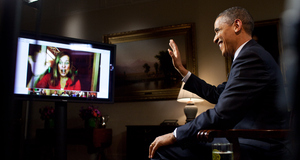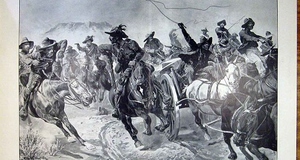Featured Article:Government Public Relations: Public Diplomacy or Propaganda?
By
2015, Vol. 7 No. 03 | pg. 1/3 | »
IN THIS ARTICLE
KEYWORDS
When politicians attempt to communicate their views in the public forum, the practice can be seen as a perquisite of the democratic process. This can prove to be an ideal environment for public relations, as the industry can identify and clarify arguments made among parties competing for information (White, L'Etang, & Moss, 2009, pp. 397-398). However, the practice can also prove troublesome for public servants. Public servants, who work in the government's public relations departments, could be labeled as enablers of partisan political communication (Gelders & Ihlen, 2010, p. 59). This dilemma proves to be more complicated to identify in our modern era. In addition to the telecommunications revolution, the worldwide spread of democracy, market economies, and digital communications has led to a more globalized world, thus allowing multiple, competing media channels to take root (Kovacs, 2006, p. 430; Signitzer & Wamser, 2005, p. 435). This digital environment, which suggests terms such as collective good and public interest, has ambiguous meanings, especially when determining whether a government or an outside organization is conveying the message (Gregory, 2005, pp. 6-7; Kovacs, 2006, p. 431). Public relations is one of many strategies that government can utilize to increase policy dialogue with citizens... But an effort must be made to maintain and promote the ethical practice of public relations to prevent public relations from becoming propaganda. This essay first defines public relations, public diplomacy and government public relations. Public relations is a very broad term because it does not suggest whether there is a two-way communicative process, nor does it imply problem solving for a specific purpose. However, the term public diplomacy implies that there is not only at least a two-way communicative process between organizations and governments, but also a problem solving process extending beyond a country's borders. However, public diplomacy may not even involve social transparency, as it can involve closed-door meetings or even military force.The second section of this essay explains how government public relations and public diplomacy are similar. Academics have confused the two terms because, not only does each term contain some functional similarities, but their academic bases have experienced tremendous growth in unison. At the end of this section, there is a brief focus on how each term is different, specifically focusing on the type of client each practice maintains primary allegiance to. The third section addresses propaganda. Particular attention is paid to relationships among target audiences and whether they are one-way or multi-way communicative processes. In the latter half of this section, I differentiate between government public relations and propaganda. Finally, the fourth section is a value assessment of government public relations, focusing on the detriments of government public relations, as well as how the practice can be beneficial for society. Public Relations, Public Diplomacy, and Government Public Relations in SummaryPublic RelationsProfessor of public relations and applied communications Jacquie L'Etang (2009) defines public relations as "the occupation held responsible for the 'management' or improvement of organizational relationships and reputation" (p. 609). Public relations as a standalone term evokes media relations practices that are common in the business world (L'Etang, 2009, p. 608; Signitzer & Wamswer, pp. 435-436). In an increasingly-globalized world, public relations has proven to be a valuable practice to understand, respect and engage in business relationships with other countries. Just a few of the issues that public relations can address include stakeholder relations, risk communication and corporate social responsibility. When forming relationships with clients both domestically and internationally, power disparities can exist at the political, economic, cultural and religious levels. For instance, prior to social engagement with a foreign country, public relations practitioners can gain knowledge about a country's culture just by looking at its views on the role of media freedom. When PR practitioners influence these levels, they can wield the power to influence the target public themselves (L'Etang, 2009, p. 609). Although public relations literature often has a corporate bias that does not discuss political ramifications in detail, one aspect that overlaps among them are the two types of public that they can attract. Active publics, as their name suggests are highly-participatory and often engage in informed dialogue with their leaders (Richards, 2004, pp. 169-170). Of course, for an active public to be present, media freedom should not only be allowed, but encouraged. Conversely, passive publics are spectators that are vulnerable to charisma and manipulation. As such, emotion takes precedence over logic in arguments (Richards, 2004, pp. 171-174). Further, there are two types of public relations types: power-based and value-based. While neither is mutually exclusive, each has distinct characteristics of their own. Power-based PR emphasizes showing the brute force of one party in the wake of an attack (Richards, 2004, p. 173). This view of PR stands in stark contrast to how most people would associate PR with an ethical profession. An example of power-based PR would include the September 11, 2001 terrorist attacks. From the point of view of Osama bin Laden and his terrorist network, the attacks proved to strike paralyzing fear in the minds of the American consciousness. These attacks were reactionary, as opposed to discriminatory in nature, because al-Qaeda used violence to achieve their goals instead of going through more ethical channels, such as diplomacy (Richards, 2004, p. 173). Value-based PR is different than power-based PR because it's main goal is about "demonstrating the client's adherence or association with certain values or standards…" (Richards, 2004, p. 173). Unlike power-based PR, value based PR's ethics is what most people would associate with mainstream PR. Using the September 11, 2001 terrorist attacks as an example, it can be argued that the U.S. practiced value-based PR after the attacks. Rather than launching an unwarranted, illegal counterattack against al-Qaeda, the U.S. media and PR practitioners used the weeks following the attacks as a way to show America's power, albeit in a way antithetical to power-based PR (Richards, 2004, p. 173). The world saw America's strength amid tragedy, using images such as of firefighters clearing the rubble, the military fighting against al-Qaeda and the completion of One World Trade Center. Richards (2004) has argued that the developments of digital technologies has fused together entertainment and marketing in the mass media, thereby stupefying targeted audiences with awe at technological sophistication and commercial power (p. 174). While this may be the case with passive publics, active publics can actually benefit from the technology and commercialization of digital media. Compared to previous decades, television and radio were less participatory for active and passive publics alike. Now, digital media has actually allowed nearly every public with free-flowing media to become more participatory than ever, thanks to forums, blogs, message boards, and the like. With target audience feedback, public relations practitioners actually have more data to work with to make their message the most effective it can be. Public DiplomacyPublic diplomacy concerns the negotiation of issues between governments (Art, 2009, p. 4; Signitzer & Wamser, 2005, pp. 437-438). As a standalone term, public diplomacy has non-controversial connotations thanks to discourse theory, as it evokes a sense of understanding between two or more competing parties (Gregory, 2005, pp. 7-10). Upon the passage of the Fulbright-Hays Act of 1961, Senator J. William Fulbright succinctly defined public diplomacy's non-controversial nature when he remarked: I utterly reject any suggestion that our educational and cultural exchange programs are weapons or instruments with which to do combat . . . there is no room and there must not be any room, for an interpretation of these programs as propaganda, even recognizing that the term covers some very worthwhile and respectable activities (Rugh, 2006, p. 50). However, as a counter-argument, history may play a role in antagonizing conflicts (Gregory, 2005, pp. 11-12). For instance, the use of public diplomacy has seen mixed results in the Israel-Palestine conflict because of the longstanding disagreement on which country lays claims to which parts of the Middle East. Since public diplomacy is carried out for interest and value reasons, disagreements may still linger among parties that have not resolved their conflicts. Much like public relations, public diplomacy entails a range of promotional and persuasive strategies working in collaboration with media relations (L'Etang, 2009, p. 610). Robert Art (2009) believed that people were motivated to come to the bargaining table because, if an agreement was not reached, it would play into their fears of failure (p. 4). The ultimate goal for public diplomacy is to foster dialogue towards solving a variety of governmental goals (Gregory, 2005, pp. 14-15). In addition to formal meeting talks between government officials, several different types of examples exist, including press interviews and staff exchange programs (Signitzer & Wamser, 2005, p. 438). Among academics, public diplomacy has been relabeled and redefined several times during the past few decades (Signitzer & Wamser, 2005, p. 438). Tuch (1990) believed that “public diplomacy is a government’s process of communicating with foreign publics in an attempt to bring about understanding for its nation’s ideas and ideals, its institutions and cultures, as well as its national goals and current policies" (p. 3). This definition suggests that there are a broad array of strategies for a home country to increase positive dialogue. In contrast, Malone's (1988) ideal of public diplomacy is that of influencing “the behavior of a foreign government by influencing the attitudes of its citizens” (p. 3). Malone's definition is more specific than Tuch's because it implies that public diplomacy works by influencing behavior of citizens, as opposed to that country's elected officials. George (2009) takes this a step further and includes the term coercive diplomacy to "back one's demand on an adversary with a threat of punishment for noncompliance that he will consider credible and potent enough to persuade him to comply with the demand" (pp. 72-74). By introducing a credible threat, George believes that public diplomacy can force other countries to comply with demands. To make matters even more complicated, some academics have classified public diplomacy under the much-broader term of strategic communication. This is not entirely surprising, as they serve very similar purposes. Gregory (2005) sums up the similarities between the two terms as: "used in response to threats and opportunities that achieve analytical and strategic relevance as they relate to particular interests and values" (p. 39). However, where the two terms differ are their theoretical and applied histories. While public diplomacy can describe the activities of a few civilian agencies (e.g. the Voice of America, USIA), strategic communication has a rich academic literature derived from social science scholarship. This scholarship, includes for instance, the analysis of political candidate campaigns and activist non-state organizations (Gregory, 2005, p. 39). Many different types of organizations conduct public diplomacy, including nations (stateless and otherwise), global organizations (corporations such as Adidas, as well as non-governmental organizations like the Catholic Church) and international political organizations (such as Greenpeace) (L'Etang, 2009, p. 610). Governments, for example, will conduct public diplomacy within their own borders using nonpolitical activities, such as a sport (L'Etang, 2009, p. 612). Global corporations use public diplomacy to compete for the loyalty of customers, shareholders and publics. NGOs use public diplomacy to gain cultural expertise, including changing identities, alliances and the heightened role of religion (L'Etang, 2009, p. 612). The formal definition of public diplomacy was influenced heavily by Habermas' theory of communicative action, which is defined as normatively-based, non-manipulative communication (Gregory, 2005, p. 13). Edward Said (1978) argued that aesthetic and scholarly texts already had a "distribution of geopolitical awareness" (p. 12). Michel Foucault's research on citizen power differences likewise proved influential. Foucault (2001) as he argued the need for public diplomacy when he laid out the two extremes of power differences among people and their government: A relationship of violence acts upon a body or upon things; it forces, it bends, it breaks, it destroys, or it closes off all possibilities. Its opposite pole can only be passivity, and if it comes up against any resistance it has no other option but to try to break it down. A power relationship, on the other hand, can only be articulated on the basis of two elements that are indispensible if it is really to be a power relationship: that 'the other' (the one over whom power is exercised) is recognized and maintained to the very end as a subject who acts; and that, faced with a relationship of power, a whole field of responses, reactions, results, and possible inventions may open up (p. 340) Public diplomacy takes into account the raw essence of power and combines it with a passive sensibility to listen to opposing views and come to a consensus. Not only does public diplomacy help to consider the views of others, it also justifies to the people why a particular course of political action aligns with the home country's long-term strategic goals (Signitzer & Wamswer, 2005, p. 438). While public diplomacy may appears straightforward, states and nations are not always attuned to the questions that public diplomacy poses. These questions include: What is the concept of truth? What does it mean to listen? Most importantly, however, what does it mean to remain open to opposing ideas while simultaneously protecting national security? (Gregory, 2005, p. 3). One of the most dramatic and recent U.S. public diplomacy failures occurred right after the September 11, 2001 terrorist attacks. Political leaders paid scant attention to public diplomacy in the wake of the attacks. The House of Representatives passed the Freedom Promotion Act of 2002, which called for: The Department of State, in coordination with the United States International Broadcasting Agency, shall develop a comprehensive strategy for the use of public diplomacy resources and assume a prominent role in coordinating the efforts of all Federal agencies involved in public diplomacy (United States 107th Congress. (2002). No counterpart measures were passed in the senate. That same year, the Strategic Communication Policy Coordinating Committee formed, with the goal of the committee as the "development of strategic communications capabilities throughout the government (United States Department of Defense, 2007). Although the White House Office of Global Communications mandated an executive order in 2003 to "facilitate the development of a strategy," a strategy never materialized and the office was closed in 2005 (Gregory, 2005, pp. 3-4). To increase the effectiveness of public diplomacy, institutional shields, known as firewalls, are employed to protect "discourse principles and imported norms in the activities of its competent elements" (Gregory, 2005, p. 15). Firewalls are often justified on three grounds: (1) through imported journalistic, educational and cultural norms; (2) the need to separate public diplomacy from covert and coercive instruments of statecraft and (3) they apply to America's long and unsuccessful to prohibit by law the sharing of public diplomacy materials with the United States (Gregory, 2005, p. 15). This raises more questions than it answers, including: are military press briefings classified under public affairs, public diplomacy, or a military information operation? Could public diplomacy and strategic communication relate to non-state actors or could it also relate to governments? Finally, as opposed to public diplomacy being a subset of strategic communication, could the opposite be true? (Gregory, 2005, p. 6). Despite America's wealth and power, the U.S. does not have a monopoly over public diplomacy because every country practices it. With charismatic leaders (or accidental personalities) dominating the limelight in public diplomacy proceedings, it may appear that public diplomacy can only be accomplished by a few (Gregory, 2005, pp. 23-24). Although these accidental personalities have the influence to pass on cultural norms to future generations, public diplomacy often cannot be accomplished by a single person. Rather, a collective of different cultural informants are needed to make public diplomacy work. Although globalization is an ideal to spread competing values amongst other state and non-state actors, America's views of right and wrong may be completely different in another country (Gregory, 2005, pp. 21-22). Government Public RelationsGovernment public relations could be considered the idealized version of public diplomacy, at least in the domestic context, because the government is identifying and clarifying arguments with constituents so they can make their own judgments. Ideally, government public relations is used with honesty and sincerity because, as an "ideology factory," several competing ideas must be addressed by the government and constituents alike (Gelders & Ihlen, 2010, p. 60). Thus, government public relations has to be treated with the utmost care, as it can be used and misused. Government public relations is even more distinctive than public relations or public diplomacy because it specifically identifies the entity that is performing public relations. In particular, government public relations is more specific than public diplomacy for two reasons: (1) it is concentrated in a specific, targeted area where the government has jurisdiction and (2) it implies that the government may not be engaging in a two-way communicative, problem solving process with another area or country. In this sense, government public relations suggests that the government is focused on solving a problem. Government public relations likewise differs from public diplomacy because, at least in western democracies, government public relations is viewed as a socially-responsible practice (Gelders & Ihlen, 2010, pp. 59-60). Of course, it is important to examine how a particular government views certain political variables, such as the roles of civil servants or democracy (if any) (Gelders & Ihlen, 2010, p. 60). Doing so will give hints to how a country's government views government public relations. For example, if a particular country's government is more authoritarian in nature, government public relations may or may not exist. If it does exist, government public relations may "indoctrinate" constituents towards taking the government's side on a policy issue. As such, the citizenry may develop a distrust of all government public relations (or communication in general), even in other countries (Gelders & Ihlen, 2010, p. 60). If government public relations does not exist in a given area, it may be absent for financial reasons or because a public relations effort has not been assigned to that particular area by the government. Recall how public diplomacy stresses cultural relativity, meaning that each country should not impose their standards of right and wrong on another country. In a sense, before any judgments are made by any country, each country tries to understand the motivation behind particular courses of action. Since government public relations occurs in a domestic context, it can be viewed as a socially-responsible practice because it embraces the cultural norms of a given country. If anything, government public relations is supposed to promote cultural values (Gelders & Ihlen, 2010, p. 60). An example of this is when a country hosts the Olympics or other high-profile event for the world to see. Government public relations is dependent upon citizen dialogue in order to survive (Gelders & Ihlen, 2010, p. 60). This makes sense, since the government cannot take a stand on a particular issue if there is no awareness or interest among its citizenry. This subsequently creates an ideal environment for the government to start the communicative process on an issue affecting the public. Some believe that, in addition to informing the public, government public relations should also influence public opinion (Gelders & Ihlen, 2010, p. 59). For example, while a particular government could inform the public on the dangers of smoking tobacco, this government could go a step further and advocate smoking cessation programs to save on healthcare costs.Continued on Next Page » Suggested Reading from Inquiries Journal
Inquiries Journal provides undergraduate and graduate students around the world a platform for the wide dissemination of academic work over a range of core disciplines. Representing the work of students from hundreds of institutions around the globe, Inquiries Journal's large database of academic articles is completely free. Learn more | Blog | Submit Latest in Business & Communications |


















